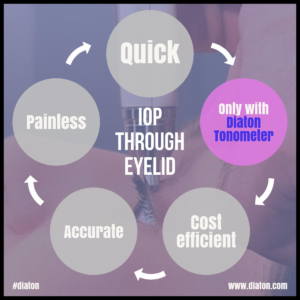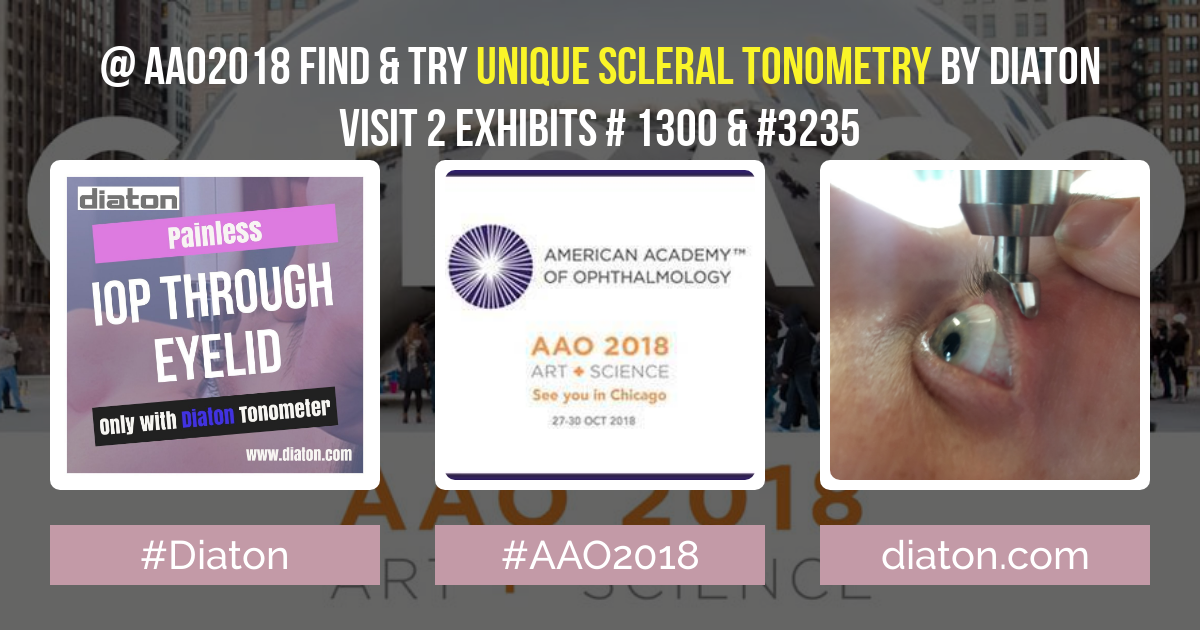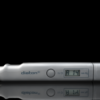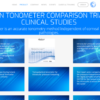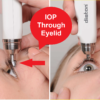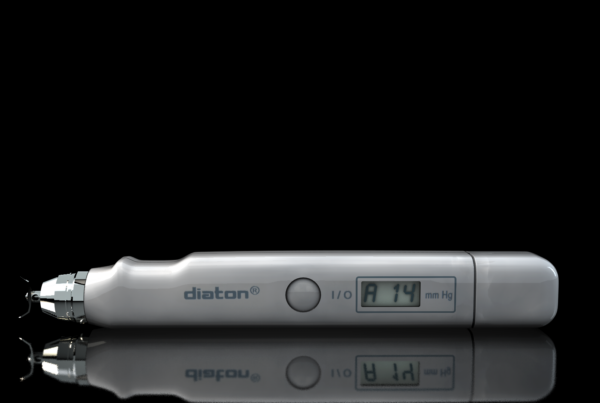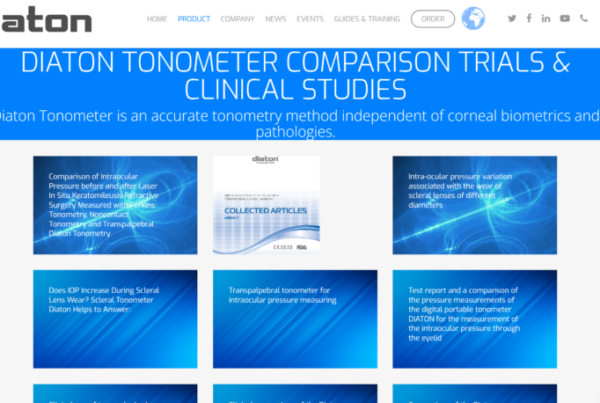Transpalpebral & Trans-scleral Tonometer Diaton will be featured at 2 Exhibits / Diaton tonometry training will be provided:
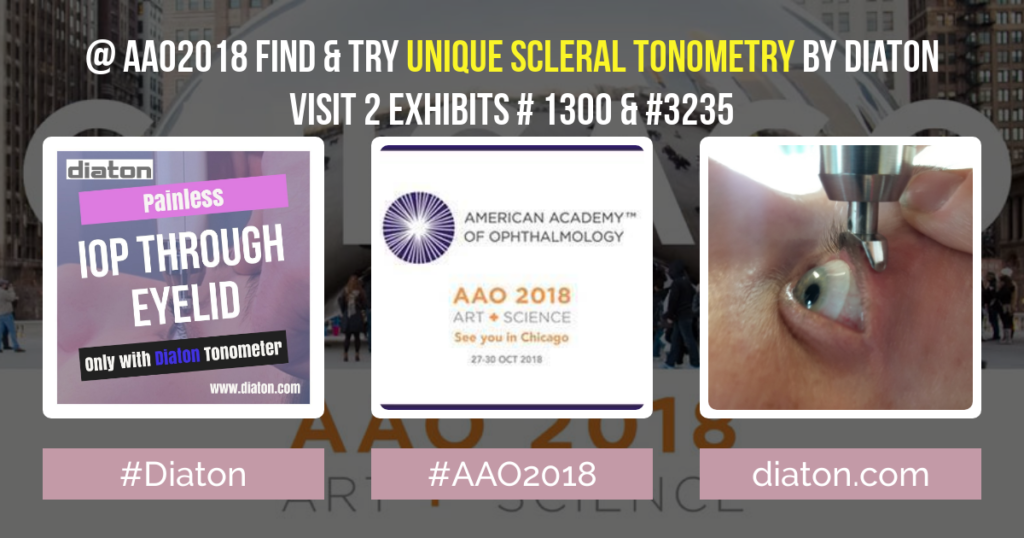
Major Benefits of Diaton Tonometer:
- Easy to use. Can be used by any trained personnel
- Quick, Puff-free & Painless (Perfect for children and adults)
- No contact with the cornea (only upper eyelid and sclera)
- No need for anesthesia drops (no side effects)
- No need to take out Contacts or Scleral lenses (Only with Diaton)
- Safe: No risk of infecting or scratching cornea (safer vs other methods)
- Cost efficient: No consumables (no need to purchase replacement tips, probes or covers, etc.)
- Latex-free, handheld, non-contact, portable, pen-like tonometer
- No sterilization (just alcohol swab is used to wipe off the tip)
- Accurate: No pachymetry needed (independent of corneal biomechanics)
- No special set-up needed (measure anytime, anywhere without the need of any other preparation before the eye examination)
- Ready-to-use: Daily calibration not required (saves time)
Diaton tonometer yields IOP readings without corneal contact
When corneal tonometry is challenging, measuring IOP through the upper eyelid at the limbus may be an alternative.
“There are certain conditions where you cannot achieve a reliable pressure through the cornea,” Emil W. Chynn, MD, FACS, MBA, of Park Avenue Laser Vision in New York, told Ocular Surgery News. Such conditions include eyes with severe scarring, corneal edema, ocular trauma or a keratoprosthesis.
“At my practice, this represents a small percentage of patients, between 5% and 10%,” Chynn said. “And for general ophthalmologists, it might be only 1% to 2% of patients.”
On the other hand, many children cannot tolerate anyone touching their eyes, so in the pediatric population, perhaps 90% of patients would do better with the Diaton pen (BiCOM) than with Goldmann applanation tonometry, Chynn said.
No contact with cornea
According to Chynn, the Diaton pen is a reputable tonometer that accurately measures IOP. Except for air-puff tonometry, other devices that measure IOP, including the gold-standard Goldmann applanation tonometry, involve contact with the cornea.
There are inherent “dangers” in using a device that touches the cornea, Chynn said, citing corneal abrasion and infection.
“The No. 1 reason non-ophthalmologists shy away from tonometry is that they are afraid of causing a corneal abrasion,” he said.
On the other hand, air-puff testing is not as accurate as Goldmann applanation tonometry.
“I suspect that most ophthalmologists would agree that the air-puff is only good as a screening device,” Chynn said.
The Diaton is useful as a screening device for non-ophthalmologists such as general practitioners, internists or emergency department physicians because there is no contact with the cornea, only the upper eyelid. “There is also no risk of infection or abrasion,” Chynn said.
Using the device
To use the Diaton, the patient either sits or lies on a chair, and then looks up at their extended thumb at an approximately 45° angle, centering the eye. The clinician gently positions the tonometer at the edge of the eyelid, so the pen is touching the edge of the limbus through the upper lid at the tarsus. The clinician then slightly lowers the pen, with that releasing the light weight probe – takes 1 second.
The device is about the size of a highlighter and features a small digital readout. The test takes less than a minute for both eyes.
Diaton Tonometer provides reliable measurements and makes it possible to diagnose glaucoma in its early stages, allowing you to devise an appropriate care and treatment plan. Diaton is effective in obtaining IOP measurements for many challenging patient populations, including: those with chronic conjunctivitis, erosions, edema and corneal dimness; people who have undergone corneal surgeries; and immobilized patients and children. Also, patients do not need to remove their contact or scleral lenses.
A busy general ophthalmologist who sees 50 patients a day could benefit from the Diaton, especially those without a certified ophthalmic medical technician, he said.
Furthermore, there are no consumables, such as replacement tips or covers, and no sterilization is required, so the Diaton is less expensive, Chynn said. And because there is no involvement of the cornea, pachymetry is bypassed to adjust for corneal biometrics.
A second-generation easy-to-use model of the Diaton debuted about 3 years ago, Chynn said.
Team Diaton & BiCOM Inc covers distribution, service and training in over 60 countries. More information on Diaton tonometers, including clinical trials data and demo video can be found at http://www.TonometerDiaton.com or by calling BiCOM Inc., at the Toll Free number 1-877-DIATONS (877.342.8667).
Diaton tonometer (Product number N477) is delivered complete with training Video/DVD describing full procedure step-by-step, battery, calibration plate, carry case in addition to the Test/Training Eye™ which is included with each N477 unit.
